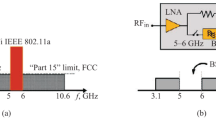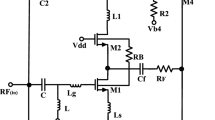Abstract
A multi-band low noise amplifier (LNA) is designed to operate over a wide range of frequencies (with center frequencies at 1.2, 1.7 and 2.2 GHz respectively) using an area efficient switchable \(\pi\) network. The LNA can be tuned to different gain and linearity combinations for different band settings. Depending upon the location of the interferers, a specific band can be selected to provide optimum gain and the best signal-to-intermodulation ratio. This is accomplished by the use of an on-chip built-in-self-test circuit. The maximum power gain of the amplifier is 19 dB with a return loss better than 10 dB for 7 mW of power consumption. The noise figure is 3.2 dB at 1 GHz and its third-order intercept point (\(IIP_3\)) ranges from −15 to 0 dBm. Implemented in a 0.13 \(\upmu\)m CMOS technology, the LNA occupies an active area of about 0.29 mm\(^2\). This design can be used for cognitive radio and other wideband applications, which require a dynamic configuration of the signal-to-intermodulation ratio, when sufficient information about the power and the location of the interferers is not available.

























Similar content being viewed by others
Notes
The third order intermodulation distortion ratio (\(IM_{3}\)) is quantified by the ratio of the third order intermodulation component to the fundamental tone. In published literature, \(IM_{3}\) is used to represent both the third order intermodulation power (stated in dBm) and the ratio of third order component to the fundamental (stated in dBc). In this paper, \(IM_{3}\) is used to represent the ratio and \(ID_{3}\) is used for the third order component power.
For simplicity the resistances \(R_g\) and \(R_{wLs}\) present in series with inductances \(L_g\) and \(L_s\) to account for their quality factors are ignored. These are however, accounted for, during the circuit simulations used to design the LNA.
If an external capacitance (\(C_{ext}\)) is added in parallel with the \(C_{gs}\) of the input NMOS transistor, the value of \(L_{g}\) can be reduced. This method however requires a large \(L_{s}\) and lowers the gain, which is quite undesirable in many applications. The use of additional components like \(C_{ext}\), however, can relax the trade-offs necessitated by (1).
The low current density could result in \(IIP_3\) degradation in some cases, which can be improved by expending more power, if necessary.
Taking just \(s_{11}\) into account, the LNA operates in the frequency range where \(s_{11}\) is better than −10 dB. Beyond this range, the return loss is unfeasible. However, even if \(s_{11}\) is worse than −10 dB while \(s_{21}\) is greater than 10 dB, this LNA configuration can be used in the receiver chain to provide better rejection to in-band intermodulation products. This has been experimentally proven, as described in Sect. 5.
The receiver noise-figure required for bluetooth and WLAN 802.11b is 23 and 14.8 dB respectively [15].
In a cognitive radio receiver, it is expected that a spectrum sensor will provide this information (architectural diagram in Fig 4).
Ignoring far re-entrant modes.
The magnitude of these coefficients in the designed amplifier at any particular frequency \(\omega\) is given by \((g_{m3}+g_{m4})(r_{o3}\parallel r_{o4})\sqrt{\frac{(x \omega ^2 L^2)^2+(x^2\omega L(1-\omega ^2LC)^2}{(x^2(1-\omega ^2LC)^2+\omega ^2L^2)^2}}\), where \(x=g_{m1}r_{o1}r_{o2} \parallel Q^2R_s\) and \(C=C_{L1},C_{L2},C_{L3}\).
References
Hong, X., Wang, J., Wang, C. X., & Shi, J. (2014). Cognitive radio in 5G: a perspective on energy-spectral efficiency trade-off. IEEE Communications Magazine, 52(7), 46–53.
Aparin, V., Brown, G., & Larson, L. E. (May 2004). Linearization of CMOS LNAs via optimum gate biasing. In IEEE International Symposium on Circuits and Systems, Vancouver, BC, Canada, vol. IV, pp. 748–751.
Ding Y., & Harjani, R. (2001). A +18 dBm IIP3 LNA in 0.35m CMOS. In IEEE International Solid-State Circuits Conference (ISSCC) Digest of Technical Papers, pp. 162–163.
Keehr, E., & Hajimiri, A. (2008). Equalization of IM3 Products in Wideband Direct-Conversion Receivers. In IEEE International Solid-State Circuits Conference (ISSCC) Digest of Technical Papers, pp. 204–205.
Bruccoleri, F., Klumperink, E. A. M., & Nauta, B. (2004). Wide-band CMOS low-noise amplifier exploiting thermal noise canceling. IEEE Journal of Solid State Circuits, 39(2), 275–282.
Chen, W., Liu, G., Zdravko, B., & Niknejad, A. M. (2008). A highly linear broadband CMOS LNA employing noise and distortion cancellation. IEEE Journal of Solid State Circuits, 43(5), 1164–1176.
Cheng, W., Annema, A., Wienk, G. J. M., & Nauta, B. (2012). A wideband IM3 cancellation technique using negative impedance for LNAs with cascode topology. In IEEE RFIC Symposium Digest, Montreal, Canada, pp. 13–16.
Bae, J.-Y., Kim, S., Cho, H.-S., Lee, I.-Y., Ha, D. S., & Lee, S.-G. (2013). A CMOS wideband highly linear low-noise amplifier for digital TV applications. IEEE Transactions on Microwave Theory and Techniques, 61(10), 3700–3711.
Kim, N., Aparin, V., Barnett, K., & Persico, C. (2006). A cellular-band CDMA CMOS LNA linearized using active post-distortion. IEEE Journal of Solid-State Circuits, 41(7), 1530–1534.
Zhang, H., Fan, X., & Snchez-Sinencio, E. (2009). A low-power, linearized, ultra-wideband LNA design technique. IEEE Journal of Solid-State Circuits, 44(2), 320–330.
Li, W., Tsai, J., Yang, H., Chou, W., Gea, S., Lu, H., et al. (2012). Parasitic-Insensitive Linearization Methods for 60-GHz 90-nm CMOS LNAs. IEEE Transactions on Microwave Theory and Techniques, 60(8), 2512–2523.
Razavi, B. (1998). RF microelectronics (Vol. 1). New Jersey: Prentice Hall.
Banerjee, G., Soumyanath, K., & Allstot, D. J. (2008). Desensitized CMOS low-noise amplifiers. IEEE Transactions on Circuits and Systems I, Regular Papers, 55(4), 752–765.
AWR website, http://www.awrcorp.com/products/microwave-office
Brandolini, M., Rossi, P., Manstretta, D., & Svelto, F. (2005). Toward multistandard mobile terminals-fully integrated receivers requirements and architectures. IEEE Transactions on Microwave Theory and Techniques, 53(3), 1026–1038.
Mazzanti, A., Sosio, M., Repossi, M., & Svelto, F. (2011). A 24 GHz subharmonic direct conversion receiver in 65 nm CMOS. IEEE Transactions on Circuits and Systems I, 58(1), 88–97.
El-Nozahi, M., Sanchez-Sinencio, E., & Entesari, E. (2009). A CMOS low-noise amplifier with reconfigurable input matching network. IEEE Transactions on Microwave Theory and Techniques, 57(5), 1054–1062.
Fu, C.-T., Ko, C.-L., Kuo, C.-N., & Juang, Y.-Z. (2008). A 2.4-5.4-GHz wide tuning-range CMOS reconfigurable low-noise amplifier. IEEE Transactions on Microwave Theory and Techniques, 56(12), 2754–2763.
Hashemi, H., & Hajimiri, A. (2002). Concurrent multiband low-noise ampli fiers-theory, design, and applications. IEEE Transactions on Microwave Theory and Techniques, 50(1), 288–301.
Reiha, M. T., & Long, J. R. (2007). A 1.2 V reactive-feedback 3.1-10.6GHz low-noise amplifier in 0.13 mCMOS. IEEE Journal of Solid State Circuits, 42(5), 1023–1033.
Ye, R.-F., Horng, T.-S., & Wu, J.-M. (2011). Wideband common-gate low- noise amplifier with dual-feedback for simultaneous input and noise matching. In Proceedings of IEEE Radio Frequency Integrated Circuits Symposium, pp. 1–4.
Sapone, G., & Palmisano, G. (2011). A 3-10-GHz low-power CMOS low- noise amplifier for ultra-wideband communication. IEEE Transactions on Microwave Theory and Techniques, 59(3), 678–686.
Bevilacqua, A., & Niknejad, A. M. (2004). An ultrawideband CMOS low- noise amplifier for 3.1–10.6-GHz wireless receivers. IEEE Journal of Solid State Circuits, 39(12), 2259–2268.
Yu, X., & Neihart, N. M. (2013). Analysis and design of a reconfigurable multimode low-noise amplifier Utilizing a multitap transformer. IEEE Transactions on Microwave Theory and Techniques, 61(3), 1236–1246.
Liscidini, A., Brandolini, M. N., Sanzogni, D., & Castello, R. (2006). A 0.13\(\mu m\) CMOS front-end, for DCS 1800/UMTS/802.11b-g with multiband positive feedback low-noise amplifier. IEEE Journal of Solid State Circuits, 41(4), 981–989.
Dao V. K., Bui Q. D., & Park, C. S. (2007). A multi-band 900 MHz/1.8GHz/5.2 GHz LNA for reconfigurable radio. In Proceedings OF IEEE Radio Frequency Integrated Circuits (RFIC) Symposium, pp. 69–71.
Hayward, W. H. (1982). Introduction to Radio Frequency Design. New Jersey: Prentice Hall.
Banerjee, G., Behera, M., Zeidan, M. A., Chen, R., & Barnett, K. (2011). Analog/RF built-in-self-test subsystem for a mobile broadcast video receiver in 65-nm CMOS. IEEE Journal of Solid State Circuits, 46, 1998–2008.
Author information
Authors and Affiliations
Corresponding author
Rights and permissions
About this article
Cite this article
Zahir, Z., Banerjee, G., Zeidan, M.A. et al. A multi-band low noise amplifier with strong immunity to interferers. Analog Integr Circ Sig Process 93, 13–27 (2017). https://doi.org/10.1007/s10470-017-1020-5
Received:
Revised:
Accepted:
Published:
Issue Date:
DOI: https://doi.org/10.1007/s10470-017-1020-5




